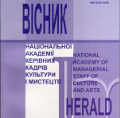МЕТАФІЗИКА ЕПОХАЛЬНИХ СИНХРОНІЗАЦІЙ І МУЗИКА
METAPHYSICS OF EPOCH SYNCHRONISATIONS AND MUSIC
Author(s): Olena Mykolayivna MarkovaSubject(s): Cultural history, Music, Metaphysics, 19th Century, Philosophy of History, History of Art
Published by: Національна академія керівних кадрів культури і мистецтв
Keywords: metaphysics of history; renaissance; culture; musical culture; epochal style of thinking; musical style;
Summary/Abstract: The purpose of this work is to trace the natural character of those historical metaphysical similarities that are laid down by the repetition of social changes from century to century and evoke the corresponding artistic and stylistic analogies based on the religious and cultural tendencies of nations. The methodological basis is the intonation approach of B. Asafiev’s school in Ukraine, comparative and hermeneutic prolongations of intonation in the works of D. Androsova, T. Verkina, O. Kozarenko, I. Kotliarevskyi, I. Liashenko, Liu Bintsyan, O. Markova, O. Muravska, O. Sokolova, with the use of scientific and research methods: art historical and analytical, descriptive and historical, cultural and regionalist, religious studies. The scientific novelty of the work is determined by the originality of the correlation of the layers of culture and art according to the logic of their epochal style and thought coincidence, including art historical parallels of ideological and state-building institutions, behavioural and ethical norms of the revolutionary strata of China and Italy in the 1840s and 1850s, the prevalence of stringed plucked instruments as a sign of Renaissance thinking in Europe and China, the capture of Rococo influences on the Cossack culture of Ukraine with a focus on woman’s creative participation. Conclusions. The discovery of Renaissance cultural features in the nations of the East obliges us to recognise analogies with Europe, which is recorded in the parallel of the life-behavioural and cultural-artistic actions of the Italian Risorgimento ("Renaissance of Italy" as the realisation of a romantic utopia) and the Chinese Taipingyang (the construction of the "Heavenly City" utopia as the Renaissance of the greatness of ancient China). The article also introduces the assertion of the original Renaissance "two worlds" in the biconfessional Jagiellonian Poland, in which the component of Cossack Ukraine demonstrated a tangent to the majestic achievements of prosaloon aristocratic instrumentalism in the life of kobzars-bandura players and song-madrigal female creative expression.
Journal: Вісник Національної академії керівних кадрів культури і мистецтв
- Issue Year: 2023
- Issue No: 2
- Page Range: 162-167
- Page Count: 6
- Language: Ukrainian

